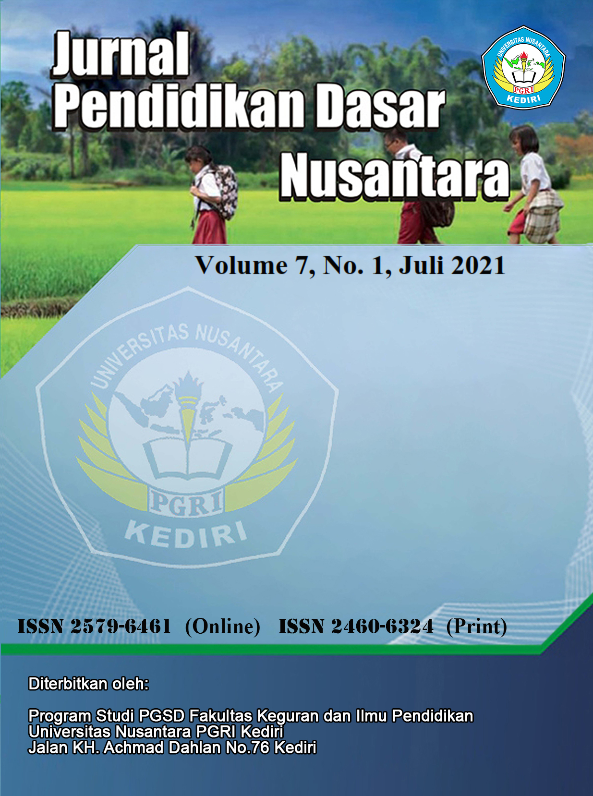Studi Literatur: Efektivitas Model Kooperatif Tipe Course Review Horay Dalam Pembelajaran IPA Di Sekolah Dasar
DOI:
https://doi.org/10.29407/jpdn.v7i1.16154Keywords:
course review horay, effectiveness of learning science, elementary schoolAbstract
Abstract: This study aims to determine the effectiveness of the Course Review Horay model in learning science in elementary schools. The method in this research uses qualitative research with data collection techniques, namely literature studies. Data collection used is by collecting, checking information or data about the findings that are different from books, proposals, various articles and journals that apply. Data that has been obtained, researched, and centered inside and outside efficiently and basically then described in a narrative. From the results of the research analysis showed that the value of the activeness and activities of students in science learning showed that there were differences in the understanding of students between cycle I and cycle II. That is, from several studies that have been applied using the Course Review Horay model, it shows that the learning effectiveness that students already have shows that they are less active in cycle I and in cycle II indicate an active category. Based on the literature study, it can be concluded that the CRH model can make it easier for students to learn, is able to make students interested or happy to learn science learning materials and this CRH model is very effective in being applied in elementary
Downloads
References
Basuki, K. (2019). Jurnal Online Internasional & Nasional Vol. 7 No.1, Januari – Juni 2019 Universitas 17 Agustus 1945 Jakarta, 53(9), 1689–1699. Retrieved from www.journal.uta45jakarta.ac.id
Dra. Desak Putu Parmiti, M. . (2013). Pengaruh model Pembelajaran Kooperatif tipe Course Review Horay (CRH) terhadap Hasil Belajar Ipa pada Siswa Kelas V SD Tahun Pelajaran 2013/2014 di Gugus IV Kecamatan Buleleng. MIMBAR PGSD Undiksha, 2(1).
Hermawan, H., Putro, K. H., & Sugini, S. (2018). The Effectiveness of Course Review Horay Method on Social Sciences Learning Achievement of Visually Impaired Students. Journal of ICSAR, 2(2), 153–157. https://doi.org/10.17977/um005v2i22018p153
Julia, A., Permatasari, R., & Susilawati, I. (2018). Penerapan model Course Review Horay (CRH) untuk meningkatkan Keaktifan Siswa pada mata pelajaran IPA di Kelas III SDN 7 Kebebu. Jurnal Pendidikan Dasar, 6(2), 66–73. https://doi.org/10.46368/jpd.v6i2.143
Kusfabianto, I. J., Kristin, F., & Anugraheni, I. (2019). Penerapan model Pembelajaran Course Review Horay untuk Meningkatkan Keaktifan dan Hasil Belajar Matematika Kelas IV SD. Jurnal Teori Dan Aplikasi Matematika, 3(2), 87–92.
Lapatta, J., Nuryanti, S., & Kendek, Y. (2015). Peningkatan Hasil Belajar siswa melalui Penggunaan model Course Review Horay pada Mata Pelajaran IPA Kelas IV SD Inpres Sintuwu. Jurnal Kreatif Tadulako, 5(8), 194–207.
Lestari, N. A. P., Sudarma, I. K., & Japa, I. G. N. (2016). Implementasi Model Pembelajaran Course Review Horay untuk Meningkatkan Aktivitas dan Hasil Belajar Siswa. Jurnal PGSD Universitas Pendidikan Ganesha, 4(1), 1–10.
Mustahidin, A. A., & Wibowo, E. W. (2016). Upaya Peningkatan Hasil Belajar IPA tentang Perubahan Kenampakan Bumi melalui Metode Course Review Horay. Ibtida’i: Jurnal Kependidikan Dasar, 3(2), 211–224.
Mutiara, F. B., Komikesari, H., & Asiah, N. (2019). Efektivitas model Kooperatif tipe Course Review Horay (CRH) terhadap Hasil Belajar Fisika Siswa. Indonesian Journal of Science and Mathematics Education, 2(1), 116–122. https://doi.org/10.24042/ijsme.v2i1.3980
Pratikno, H., & Dewanti, S. S. (2014). Efektivitas model Pembelajaran Missouri Mathematics Project (MMP) Dilengkapi Metode Course Review Horey (CRH) terhadap Peningkatan Motivasi dan Hasil Belajar Siswa. Kaunia, 5(1), 20–29. Retrieved from http://ejournal.uin-suka.ac.id/saintek/kaunia/article/view/1062
Rozi, F., & Hanum, C. B. (2019). Seminar Nasional Pendidikan Dasar Universitas Negeri Medan. Seminar Nasional Pgsd Unimed, 2(1), 246–311. Retrieved from https://jurnal.unimed.ac.id/2012/index.php/snpu/article/view/16127
Sarwono, J. (2006). Metode Penelitian Kuantitatif dan Kualitatif. Yogyakarta: Graha Ilmu.
Siutriani, N. W., Arini, N. W., & Garminah, N. N. (2016). Penerapan model Course Review Horay Berbantuan Media Monopoli untuk meningkatkan Keaktifan dan Hasil Belajar IPA. E-Journal PG PAUD Universitas Pendidikan Ganesha, 4(1), 1-10. Retrieved from https://ejournal.undiksha.ac.id/index.php/JJPGSD/article/view/7271/4968
Sugiyono. (2010). Metode Penelitian Pendidikan Pendekatan Kuantitatif, Kualitatif, dan R&D. Bangdung: Alfabeta.
Surabaya, U. N. (2018). Pengaruh Model Pembelajaran Course Review Horay ( CRH ) Terhadap Hasil Belajar Siswa Kelas IV SDN Gilang I Pada Materi Penggolongan Hewan Berdasarkan Jenis Makanannya. 06, 1610-1620.
Huda, Miftahul. 2013. Model-Model Pengajaran dan Pembelajaran. Yogyakarta: Pustaka Belajar.
Samatowo, Usman. 2011. Pembelajaran IPA di Sekolah Dasar. Jakarta: Indeks. Cet. 2.
Samiudin. 2016. Peran Metode Untuk Mencapai Tujuan Pembelajaran. dalam JSI (Jurnal Studi Islam), Vol. 11, No. 2, 2016.
Trianto. 2013. Model Pembelajaran Terpadu. Jakarta: PT Bumi Aksara.
Astuti, Lilin. 2016. Pemanfaatan Media dalam Pembelajaran IPA (Reporsitpry: IAIN Purokerto, Edu).
Downloads
Published
Issue
Section
License
Authors who publish with this journal agree to the following terms:
- Copyright on any article is retained by the author(s).
- The author grants the journal, the right of first publication with the work simultaneously licensed under a Creative Commons Attribution License that allows others to share the work with an acknowledgment of the work’s authorship and initial publication in this journal.
- Authors are able to enter into separate, additional contractual arrangements for the non-exclusive distribution of the journal’s published version of the work (e.g., post it to an institutional repository or publish it in a book), with an acknowledgment of its initial publication in this journal.
- Authors are permitted and encouraged to post their work online (e.g., in institutional repositories or on their website) prior to and during the submission process, as it can lead to productive exchanges, as well as earlier and greater citation of published work.
- The article and any associated published material is distributed under the Creative Commons Attribution-ShareAlike 4.0 International License

































